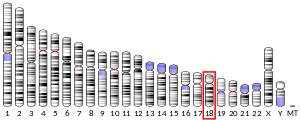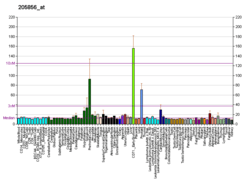Urea transporter 1
Urea transporter 1 is a protein that in humans is encoded by the SLC14A1 gene.[5][6]
Function
The SLC14A1 codes for a urea transporter (UTB) that is expressed in erythrocytes and kidney. SLC14A2 and SLC14A1 constitute solute carrier family 14. UTB proteins constitute the Kidd antigen system.
gollark: <@319753218592866315> Yep!
gollark: It's kind of broken and bad.
gollark: Look, I'm *working on it*...
gollark: Apparently it interprets the `#` bit as a selector or something? I don't know.
gollark: I'm still trying to figure where it even stores the page a comment is on.
References
- GRCh38: Ensembl release 89: ENSG00000141469 - Ensembl, May 2017
- GRCm38: Ensembl release 89: ENSMUSG00000059336 - Ensembl, May 2017
- "Human PubMed Reference:". National Center for Biotechnology Information, U.S. National Library of Medicine.
- "Mouse PubMed Reference:". National Center for Biotechnology Information, U.S. National Library of Medicine.
- Olives B, Mattei MG, Huet M, Neau P, Martial S, Cartron JP, Bailly P (Aug 1995). "Kidd blood group and urea transport function of human erythrocytes are carried by the same protein". J Biol Chem. 270 (26): 15607–10. doi:10.1074/jbc.270.26.15607. PMID 7797558.
- "Entrez Gene: SLC14A1 solute carrier family 14 (urea transporter), member 1 (Kidd blood group)".
Further reading
- Geitvik GA, Høyheim B, Gedde-Dahl T, et al. (1987). "The Kidd (JK) blood group locus assigned to chromosome 18 by close linkage to a DNA-RFLP". Hum. Genet. 77 (3): 205–9. doi:10.1007/BF00284470. PMID 2890568.
- Olives B, Neau P, Bailly P, et al. (1995). "Cloning and functional expression of a urea transporter from human bone marrow cells". J. Biol. Chem. 269 (50): 31649–52. PMID 7989337.
- Davey S, Beach D (1996). "RACH2, a novel human gene that complements a fission yeast cell cycle checkpoint mutation". Mol. Biol. Cell. 6 (10): 1411–21. doi:10.1091/mbc.6.10.1411. PMC 301296. PMID 8573795.
- Olivès B, Martial S, Mattei MG, et al. (1996). "Molecular characterization of a new urea transporter in the human kidney". FEBS Lett. 386 (2–3): 156–60. doi:10.1016/0014-5793(96)00425-5. PMID 8647271.
- Olivès B, Merriman M, Bailly P, et al. (1997). "The molecular basis of the Kidd blood group polymorphism and its lack of association with type 1 diabetes susceptibility". Hum. Mol. Genet. 6 (7): 1017–20. doi:10.1093/hmg/6.7.1017. PMID 9215669.
- Lucien N, Sidoux-Walter F, Olivès B, et al. (1998). "Characterization of the gene encoding the human Kidd blood group/urea transporter protein. Evidence for splice site mutations in Jknull individuals". J. Biol. Chem. 273 (21): 12973–80. doi:10.1074/jbc.273.21.12973. PMID 9582331.
- Irshaid NM, Thuresson B, Olsson ML (1998). "Genomic typing of the Kidd blood group locus by a single-tube allele-specific primer PCR technique". Br. J. Haematol. 102 (4): 1010–4. doi:10.1046/j.1365-2141.1998.00874.x. PMID 9734652.
- Sidoux-Walter F, Lucien N, Olivès B, et al. (1999). "At physiological expression levels the Kidd blood group/urea transporter protein is not a water channel". J. Biol. Chem. 274 (42): 30228–35. doi:10.1074/jbc.274.42.30228. PMID 10514515.
- Irshaid NM, Henry SM, Olsson ML (2000). "Genomic characterization of the kidd blood group gene:different molecular basis of the Jk(a-b-) phenotype in Polynesians and Finns". Transfusion. 40 (1): 69–74. doi:10.1046/j.1537-2995.2000.40010069.x. PMID 10644814.
- Sidoux-Walter F, Lucien N, Nissinen R, et al. (2000). "Molecular heterogeneity of the Jk(null) phenotype: expression analysis of the Jk(S291P) mutation found in Finns". Blood. 96 (4): 1566–73. PMID 10942407.
- Lucien N, Chiaroni J, Cartron JP, Bailly P (2002). "Partial deletion in the JK locus causing a Jk(null) phenotype". Blood. 99 (3): 1079–81. doi:10.1182/blood.V99.3.1079. PMID 11807016.
- Irshaid NM, Eicher NI, Hustinx H, et al. (2002). "Novel alleles at the JK blood group locus explain the absence of the erythrocyte urea transporter in European families". Br. J. Haematol. 116 (2): 445–53. doi:10.1046/j.1365-2141.2002.03238.x. PMID 11841450.
- Lucien N, Sidoux-Walter F, Roudier N, et al. (2002). "Antigenic and functional properties of the human red blood cell urea transporter hUT-B1". J. Biol. Chem. 277 (37): 34101–8. doi:10.1074/jbc.M205073200. PMID 12093813.
- Strausberg RL, Feingold EA, Grouse LH, et al. (2003). "Generation and initial analysis of more than 15,000 full-length human and mouse cDNA sequences". Proc. Natl. Acad. Sci. U.S.A. 99 (26): 16899–903. doi:10.1073/pnas.242603899. PMC 139241. PMID 12477932.
- Ota T, Suzuki Y, Nishikawa T, et al. (2004). "Complete sequencing and characterization of 21,243 full-length human cDNAs". Nat. Genet. 36 (1): 40–5. doi:10.1038/ng1285. PMID 14702039.
- Inoue H, Jackson SD, Vikulina T, et al. (2004). "Identification and characterization of a Kidd antigen/UT-B urea transporter expressed in human colon". Am. J. Physiol., Cell Physiol. 287 (1): C30–5. doi:10.1152/ajpcell.00443.2003. PMID 14985236.
This article is issued from Wikipedia. The text is licensed under Creative Commons - Attribution - Sharealike. Additional terms may apply for the media files.




